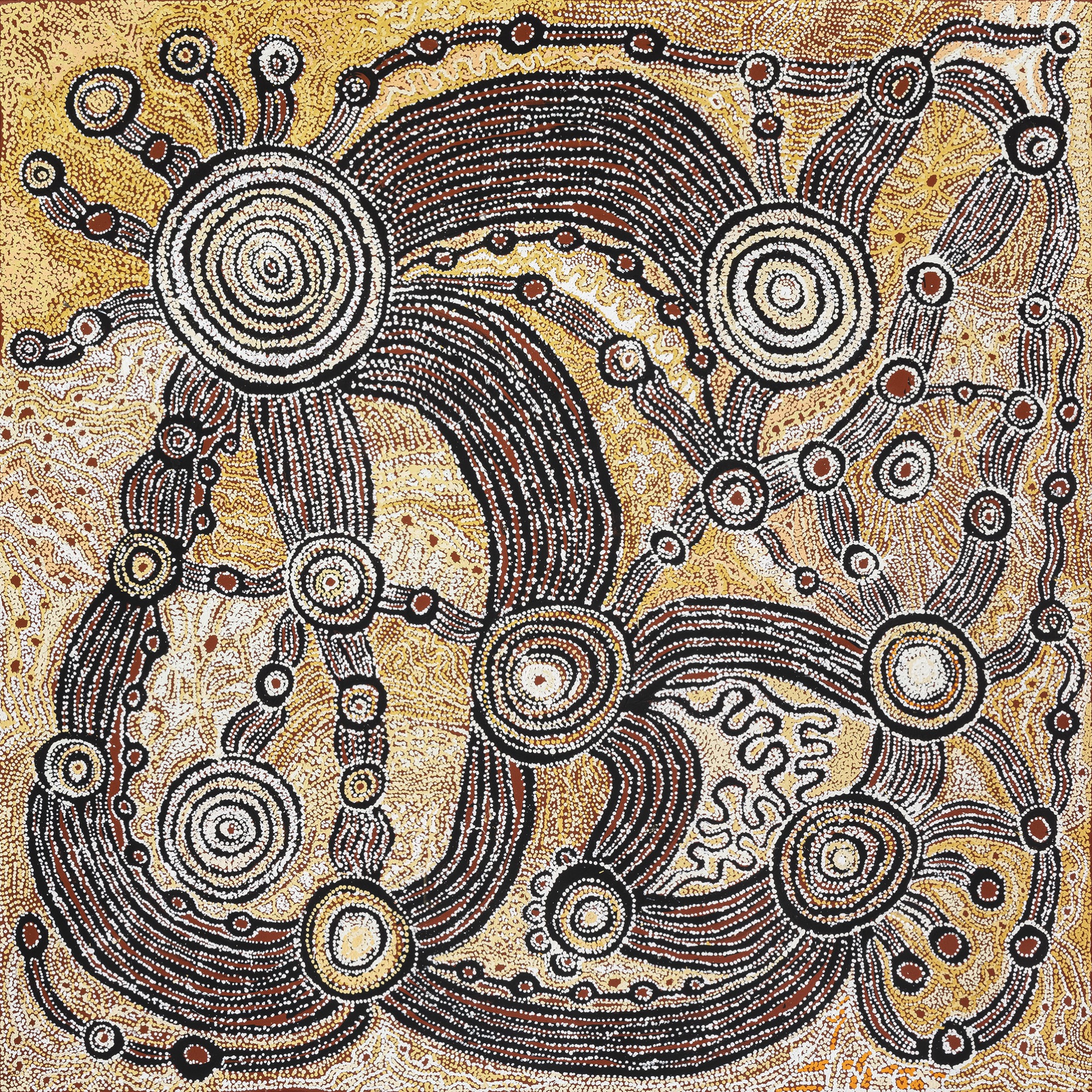Leah Brady
07/10/2023 - 28/10/2023
Leah Brady
Wanampi Tjukurpa / Piltati
2023
acrylic on linen
200.00 x 200.00 cm
inscribed verso: artist's name and APY Adelaide Studio cat. 380-23
Sold
Leah Brady
WANAMPI TJUKURPA / PILTATI
LEAH BRADY
“This story tells of two snake brothers and their wives, who are sisters, that lived near Piltati, west of Amata. Every day the women went out hunting, and every evening they bought home kuka (meat for cooking) for the men, who didn’t do anything but perform ceremonies. After a while the sisters became annoyed at the men’s laziness and decided to eat all the food they caught, leaving the men to fend for themselves. The snake brothers were angry, and decided to punish the women for their insubordination. After lots of talking, the brothers agreed to change themselves into a Wanampi (a giant mythical water serpent, which also had the power to travel above and below ground) and play a practical joke upon the women. They went to a marsupial rat hole where the women had been digging and imitated the tracks of a large snake by rubbing the back of a spear thrower on the ground. Then they entered the hole, and one of them left out enough of his tail for the women to see. The younger sister became very excited when she saw the tracks of such a large snake and its tail popping out. She begun to pull the snake from its burrow, but the tail kept slipping from her grasp. Again and again he let himself be caught before wriggling free once more. Eventually the younger sister became tired, gave up and returned to her sister. In evening, when they were eating dinner, the younger sister told her elder sister how she had almost caught a carpet snake as big as a Wanampi, but couldn’t pull it from its burrow as it was too strong. The big sister said she would help her to catch it the next day. The next morning the women set off with their wana (digging sticks) and piti (large wooden bowl). They dug all day long, then the next day and the next, occasionally glimpsing the snake. They continued to dig after the Wanampi, but they never caught him. In their pursuit the women dug a trench from Aparatjara to Piltati, now a watercourse, approximately 25km long.
Their burrow became deeper, and the women dug many subsidiary branches in their pursuit, creating the gorge at Piltati, with its creeks and piles of rock that clutter the valley floor. Finally the elder sister changed her tactics. She dug a pit ahead of the entrance to the burrow (now the largest rock hole at Piltati), uncovering the Wanampi before he could get away, then she threw her digging stick, piercing the side of the Wanampi. The younger Wanampi left the burrow, chased and swallowed his wife, the younger sister. The injured snake (big brother) was angry and in great pain, so he caught, killed and ate the elder sister at the mouth of Piltati gorge.”
The APY Art Centre Collective is a social enterprise made up of 11 Aboriginal owned and governed arts and culture organisations from the Anangu Pitjantjatjara Yankunytjatjara (APY) Lands. As a collective, these organisations work to increase income for Aboriginal artists and support the important work of art centres in APY communities. This artwork was made at the APY Art Centre Collective operated APY Studio in Adelaide, which provides APY artists with a satellite art centre for artists off ‘Country’. The APY Studio affords APY artists with income stability alongside culturally appropriate support to access healthcare and the opportunity to maintain vital cultural and community connections when in Adelaide.









